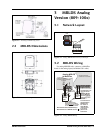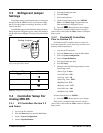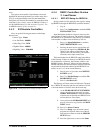
14 • MRLDS I&O Manual 026-1307 Rev 1 11-30-07
“MV” should be entered for sensor inputs that read fault
status.
Gain and Offset
Since the output terminals emit one volt for every 250
ppm of refrigerant detected, the gain for the refrigerant leak
sensors must be set to 250 and the Offset to 0.
The sensors configured to detect faults must be given a
gain of 1000; this way, the REFLECS can be set up to
alarm whenever it detects a 5000 mV signal.
4.4.5.4 Alarm Setpoints
Locate the screen in the BEC or RMCC where sensor
alarm set points are specified. This is usually a menu option
in the Sensors Menu, which may be reached from the Main
Menu.
The REFLECS should now be capable of interpreting
the 0-4.8V output voltage as a refrigerant concentration of
0-1200 ppm and the 5V output voltage as a fault. The de-
sired alarm set points must now be specified. When set up
correctly, alarms will appear in the REFLECS Alarm log as
“Hi Sensor” alarms (refer to the REFLECS manual for
alarm descriptions).
Alarms: High
In this field, specify a high alarm setpoint for refriger-
ant leak alarms between 0 and 1200 ppm. For fault status
alarms, enter a setpoint of 4960 mV (slightly below 5V, as
a precautionary measure).
Alarms/Notices Dly
The value entered in the Alarms Dly field is the number
of minutes the sensor reading must be above the
Alarms:High set point before the REFLECS may generate
a leak alarm
When choosing an alarm delay, keep in mind the
amount of time it takes an IRLDS to complete a sampling
cycle. For example, a 16-valve IRLDS with 30 second sam-
pling times for each zone takes a total of eight minutes to
sample all zones. Choosing an alarm delay smaller than the
IRLDS’s cycle time will cause an alarm to be generated af-
ter only one high reading is taken.
5 Diagnostics
5.1 MRLDS LED Indica-
tors
The MRLDS has three LEDs for quick status indica-
tion.
For analog output models, a fault is signaled by setting
the voltage to 0.5V, which indicates the MRLDS should be
be replaced. Call the CPC Service Department (770-425-
2724) to verify if the MRLDS unit should be replaced.
5.2 E2 Alarming
5.2.1 IRLDS Mode
If any one or all of the MRLDS sensors encounters a
problem, the IRLDS application will alarm and all cell
outputs will show NONE. For details on which individual
unit is in alarm, go to the MRLDS Gateway and check the
Status screen on the HHT.
5.2.2 16AI Mode
If an MRLDS has lost communication, the input will
go to 1250 PPM, which should force an alarm if enabled.
If all MRLDS sensors lose communication, the 16AI will
go offline. Check the Status screen on the HHT for details.
MRLDS
LEDs
STATUS INDICATION
Green Lights during normal operation
Red Flashes at 0.5 Hz during start-up
Turns ON solid if concentration
reading exceeds 50 ppm
Yellow Flashes at 0.5 Hz if power sup-
plied is outside set limits
Turns ON solid during other fault
conditions
Table 5-1
- MRLDS LED Status


















